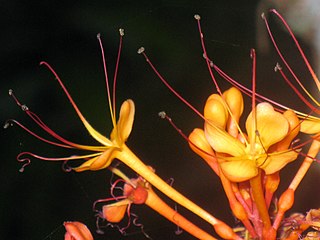
The Rutaceae is a family, commonly known as the rue or citrus family, of flowering plants, usually placed in the order Sapindales.

In the botanical classification of plants, Aeridinae Pfitzer is a subtribe of the tribe Vandeae whose representatives all have a monopodial growth habit and do not possess pseudobulbs.

The trifoliate orange, Citrus trifoliata, is a member of the family Rutaceae. Whether the trifoliate oranges should be considered to belong to their own genus, Poncirus, or be included in the genus Citrus is debated. The species is unusual among citrus for having deciduous, compound leaves and pubescent (downy) fruit.

Murraya is a genus of flowering plants in the citrus family, Rutaceae. It is distributed in Asia, Australia, and the Pacific Islands. The center of diversity is in southern China and Southeast Asia. When broadly circumscribed, the genus has about 17 species. A narrower circumscription contains only eight species, others being placed in Bergera and Merrillia.

The curry tree or Bergera koenigii, is a tropical and sub-tropical tree in the family Rutaceae, native to Asia. The plant is also sometimes called sweet neem, though M. koenigii is in a different family from neem, Azadirachta indica, which is in the related family Meliaceae.

The Orchidoideae, or the orchidoid orchids, are a subfamily of the orchid family (Orchidaceae) that contains around 3630 species. Species typically have a single (monandrous), fertile anther which is erect and basitonic.

Zanthoxylum is a genus of about 250 species of deciduous and evergreen trees, shrubs and climbers in the family Rutaceae that are native to warm temperate and subtropical areas worldwide. It is the type genus of the tribe Zanthoxyleae in the subfamily Rutoideae. Several of the species have yellow heartwood, to which their generic name alludes. Several species are cultivated for their use as spices, notably including Sichuan pepper.

Phyllanthus is the largest genus in the plant family Phyllanthaceae. Estimates of the number of species in this genus vary widely, from 750 to 1200. Phyllanthus has a remarkable diversity of growth forms including annual and perennial herbs, shrubs, climbers, floating aquatics, and pachycaulous succulents. Some have flattened leaflike stems called cladodes. It has a wide variety of floral morphologies and chromosome numbers and has one of the widest range of pollen types of any seed plant genus.

Saraca L. is a genus of flowering plants in the family Fabaceae of about 20 plant species of trees native to the lands from India and Sri Lanka to Indochina, southern China Malesia, and New Guinea.

Glycosmis is a genus of flowering plants in the citrus family, Rutaceae and tribe Clauseneae. It is in the subfamily Aurantioideae, which also includes genus Citrus. It is a genus of the subtribe Clauseninae, which are known technically as the remote citroid fruit trees.
Limnocitrus is a genus of plant in the family Rutaceae with one species, Limnocitrus littoralis. It is native to Vietnam and Indonesia, where it is found on the island of Java in Jepara. In traditional Vietnamese medicine different parts of the plant have been used as an expectorant, antitussive product, for exudation, and the treatment of colds and fevers.
Merrillia is a monotypic genus of flowering plants in the citrus family, Rutaceae, containing the single species Merrillia caloxylon. Its English language common names include flowering merrillia, katinga, and Malay lemon. In Malaysia it is called ketenggah and kemuning gajah. The species is native to Malaysia, Thailand, and Sumatra in Indonesia.

Aurantioideae is the subfamily within the rue and citrus family (Rutaceae) that contains the citrus. The subfamily's center of diversity is in the monsoon region of eastern Australasia, extending west through South Asia into Africa, and eastwards into Polynesia.

Cercidoideae is a subfamily in the pea family, Fabaceae. Well-known members include Cercis (redbuds), including species widely cultivated as ornamental trees in the United States and Europe, Bauhinia, widely cultivated as an ornamental tree in tropical Asia, and Tylosema, a semi-woody genus of Africa. The subfamily occupies a basal position within the Fabaceae and is supported as monophyletic in many molecular phylogenies. At the 6th International Legume Conference, the Legume Phylogeny Working Group proposed elevating the tribe Cercidae to the level of subfamily within the Leguminosae (Fabaceae). The consensus agreed to the change, which was fully implemented in 2017. It has the following clade-based definition:
The most inclusive crown clade containing Cercis canadensisL. and Bauhinia divaricataL. but not Poeppigia proceraC.Presl, Duparquetia orchidaceaBaill., or Bobgunnia fistuloides(Harms) J.H.Kirkbr. & Wiersema.

Hung Ta Chang, was a Chinese botanist and ecologist.

Atalantia is a genus of flowering plants in the citrus family, the Rutaceae.

Feroniella is a genus in the family Rutaceae, the only species being Feroniella lucida. The genus is placed within Citrus by some sources, with the species becoming Citrus lucida. Feroniella lucida is a fruit-bearing tree native to Cambodia, Laos, Thailand, Vietnam and the island of Java, Indonesia.

Harrisonia is a small genus of flowering plants in the subfamily Cneoroideae of the Rutaceae. Older taxonomic treatments have placed this genus in the Simaroubaceae.
Stauranthera is a genus of flowering plants in the family Gesneriaceae, native to Bangladesh, the Nicobar Islands, Assam, the eastern Himalayas, south-central and southeast China, Southeast Asia, and Malesia to New Guinea. It is very close morphologically and genetically to Loxonia.
















